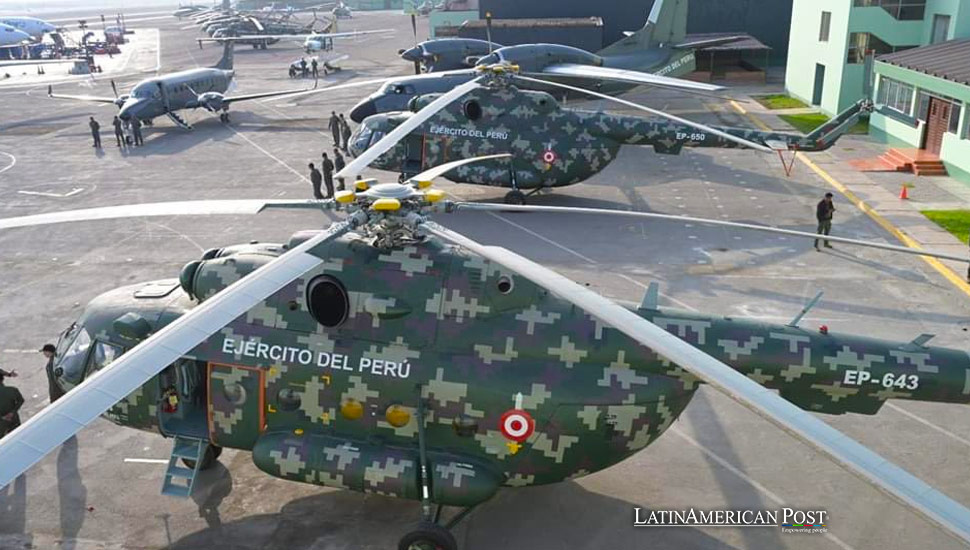Peruvian Army Aviation Boosts Capacity with Modernized Fleet

The Peruvian Army Aviation has significantly enhanced its operational capacity by receiving six helicopters and five aircraft, modernized and upgraded by the Specialized Aeronautical Maintenance Battalion (Bemae). This development marks a substantial step in ensuring national defense and emergency response readiness.
The Peruvian Army Aviation has made a significant leap in its operational capabilities following the Specialized Aeronautical Maintenance Battalion (Bemae) ‘s modernization of six helicopters and five aircraft. The Ministry of Defense announced this advancement, emphasizing the enhanced readiness to address emergencies and national defense needs. The ceremony, attended by Defense Minister Walter Astudillo, highlighted the addition of four MI 17 helicopters, two Augusta 109K helicopters, two Antonov 32B aircraft, two Beechcraft, and one Caravan to the Army’s fleet.
Upgraded Aircraft for Enhanced Operations
The modernization process occurred at Bemae, situated within the Army Aviation facilities in the port province of Callao, near Lima. This initiative was part of a comprehensive repair and significant maintenance program funded in response to the El Niño climate phenomenon. The upgraded fleet’s operational readiness was showcased in a ceremony featuring notable military figures, including the Chief of the Joint Command of the Armed Forces, David Ojeda, and the Army’s General Commander, César Briceño.
These upgrades are set to significantly bolster the Peruvian Army’s capabilities in disaster response and national defense. “This reintegration into the Army’s air fleet will not only enable us to manage emergencies effectively but also to ensure national defense and sovereignty,” the Ministry of Defense stated.
Comparing Regional Military Aviation Strengths
When comparing the Peruvian Army Aviation’s enhancements to other Latin American air forces, notable differences and similarities emerge. Brazil’s Air Force, for instance, is one of the most advanced in the region, with a diverse fleet that includes modern fighter jets like the Gripen E, transport aircraft, and a robust helicopter fleet. This diversification allows Brazil to conduct various operations, from combat missions to humanitarian aid.
Argentina’s Air Force, on the other hand, has faced challenges in maintaining and modernizing its fleet due to economic constraints. However, recent acquisitions and upgrades, such as the procurement of Texan II training aircraft and the modernization of Pampa III jets, have aimed to restore some operational capabilities. Similarly, Colombia has focused on enhancing its counterinsurgency and anti-narcotics operations with a Black Hawk helicopter and Super Tucano aircraft fleet.
In this regional context, Peru’s recent upgrades position it competitively. The addition of modernized MI 17 and Augusta 109K helicopters, known for their versatility and performance, along with the reliable Antonov 32B transport aircraft, strengthens Peru’s ability to conduct varied missions. These include disaster relief, medical evacuations, and logistical support in remote areas.
Strategic Importance of Modernization
The modernization of Peru’s Army Aviation is a strategic move that aligns with broader defense objectives. As climate change continues to pose significant challenges, the ability to respond swiftly to natural disasters is crucial. The upgraded fleet enhances Peru’s preparedness for such emergencies, providing a rapid response capability that can save lives and reduce the impact of disasters.
Moreover, the enhancements contribute to Peru’s national security by improving the military’s operational readiness. The ability to efficiently transport troops, equipment, and supplies across the country’s diverse geography—from coastal regions to the Andean highlands and the Amazon rainforest—is vital for maintaining territorial integrity and sovereignty.
Future Prospects and Regional Collaboration
Looking ahead, the continued modernization and maintenance of the fleet will be essential for sustaining these capabilities. The Ministry of Defense’s commitment to investing in the Army Aviation’s infrastructure and equipment reflects an understanding of the evolving security landscape and the need for a robust, responsive military force.
Regional collaboration and information exchange could also benefit Peru’s military aviation. By learning from the experiences of other Latin American air forces, Peru can adopt best practices in fleet management, pilot training, and operational tactics. Joint exercises and cooperative initiatives can enhance regional security and disaster response capabilities.
Also read: Peru Authorizes Barrick Mining Near Border Amid Controversy
The Peruvian Army Aviation’s recent upgrades mark a significant step forward in enhancing the country’s defense and emergency response capacities. By comparing these advancements with those of other Latin American air forces, it is evident that Peru is making strategic investments to secure its national interests and contribute to regional stability. The modernization of the fleet not only ensures immediate operational readiness but also sets the stage for continued improvements in the future.





